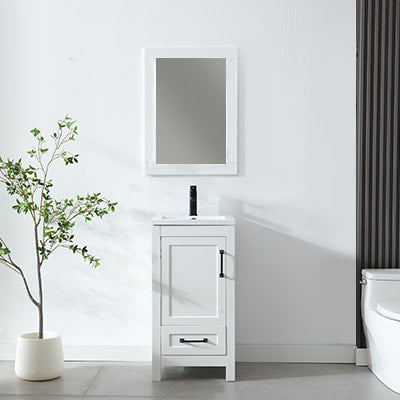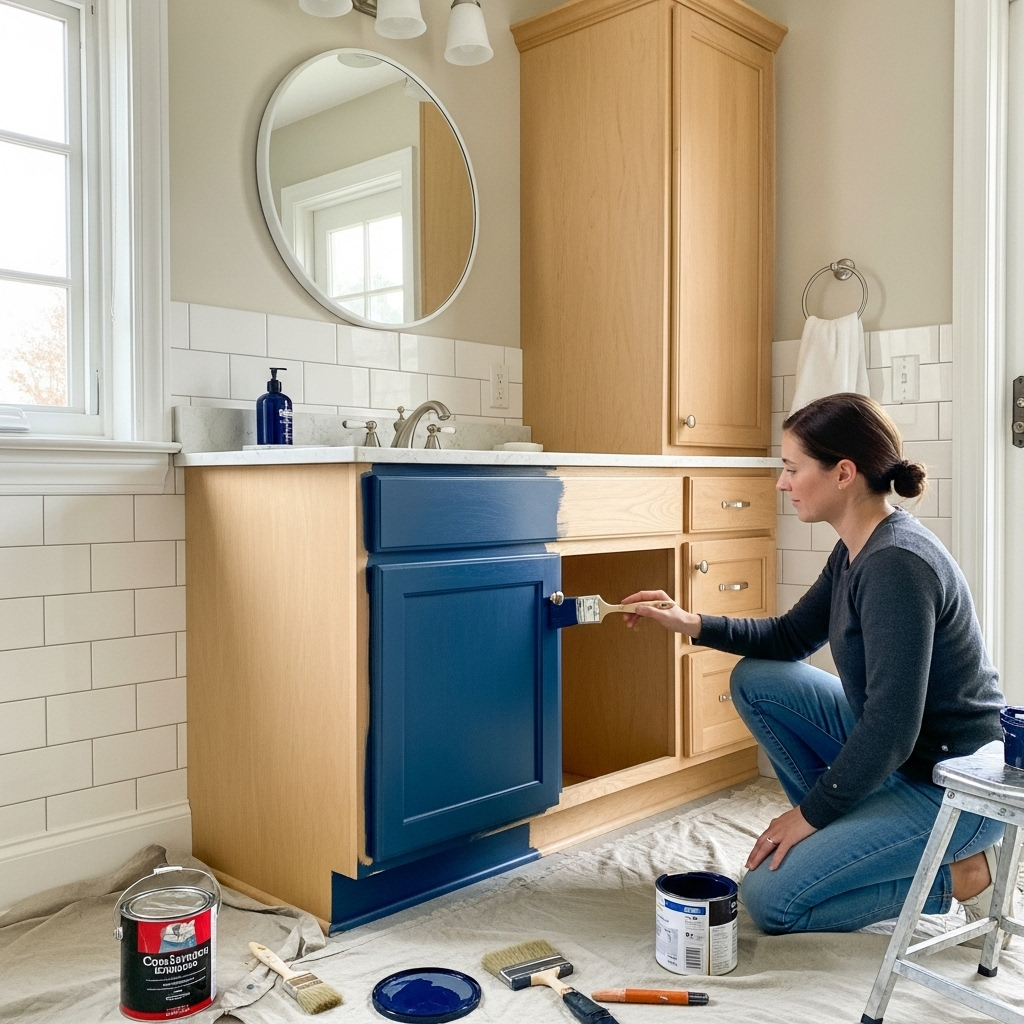That frustrating struggle every time you try to open a bathroom vanity cabinet door—the pulling, the grating screech of wood rubbing against wood, the visible signs of swelling and warping. It's a common household headache. Bathrooms, being high-humidity zones, cause wooden cabinet doors to absorb moisture and expand, leading to difficulty opening and closing, sometimes to the point of becoming completely stuck.
But don't rush to replace the entire bathroom vanity just yet. In many cases, this problem can be solved with straightforward cabinet repair methods. This article provides a detailed guide to fixing swollen cabinet doors and practical methods to fix those swollen bathroom cabinet doors.
Understanding Why Bathroom Cabinet Doors Swell

Wood naturally absorbs moisture from humid environments, causing it to expand. This "shrinkage and swelling" characteristic of wood is the primary culprit behind the warping and cracking of solid wood bathroom cabinets.
When the air is very dry, wood loses moisture and shrinks; conversely, when humidity increases, it absorbs moisture and expands slightly.
It's crucial to note that wood doesn't swell or shrink uniformly. Tangential shrinkage is the greatest, followed by radial shrinkage, while longitudinal shrinkage is minimal. During drying, tangential shrinkage is about 6%-12%, radial shrinkage is 3%-6%, and longitudinal is only 0.1%-0.35%.
It's this uneven expansion and contraction that causes wood to warp and distort.
Diagnosing the Problem: Assessing the Swelling and Choosing a Solution

Before starting repairs, accurately diagnose the issue:
Minor Swelling: The door meets slight resistance but still closes fully.
Moderate Swelling: The door clearly rubs against the cabinet frame, requiring significant force to open and close.
Severe Swelling: The door is completely stuck, won't close, or the hinge area is damaged.
Choose the appropriate repair method for cabinets based on the severity.
Repair Method 1: Sanding the Swollen Edges

For mild to moderate swelling, the simplest method is to sand down the excess material.
Step-by-Step Guide:
1. Remove the Door: Unscrew and detach the cabinet door from its hinges using a screwdriver.
2. Identify the Friction Points: Gently close the door (if possible) and observe where it contacts the frame. Alternatively, slide a piece of paper between the door and frame to pinpoint the tight spots.
3. Sand the Areas: Use coarse-grit sandpaper (or a hand plane for more material removal) to carefully sand down the swollen areas.
4. Crucial Tip: Remove only a small amount of material at a time, frequently testing the fit to avoid over-sanding.
5. Seal the Wood: Once the door fits properly, immediately seal the newly exposed wood with a wood sealant, varnish, or wood wax to prevent future moisture absorption and protect your bathroom furniture.
Repair Method 2: Repairing Hinges and Screw Holes

Over time, cabinet hinge screws can become enlarged and stripped, causing the door to sag or misalign.
Solutions:
1. Remove the hinge and inspect the screw holes for damage.
2. For Stripped Holes: Take a small section of a wood toothpick or matchstick, apply a dab of wood glue, insert it into the hole, and break it off flush. Once the glue dries, you can re-screw the hinge into the new, solid wood.
3. Alternatively, dip several small wood slivers into glue and tap them into the original hole. After the glue cures, chisel the protruding parts flush.
4. Reinstall the original screw into the repaired hole.
5. Consider using longer screws or specialized "hinge repair plates" for added strength.
Repair Method 3: Using Specialized Hinge Repair Plates

If the wood around the hinge is severely damaged, specialized hinge repair plates can be an effective solution.
Procedure:
1. Purchase hinge repair plates of a suitable size; they usually come with matching screws.
2. Position the repair plate on the cabinet's interior, marking the screw locations.
3. Install the repair plate. Use the provided screws for the new, smaller holes, and you can often reuse the original hinge screws for the larger holes.
4. Finally, attach the hinge to the repair plate.
One user who tried this method shared: "The realigned door sits slightly off, not perfectly flush with the adjacent one, but it's far better than it being completely off. The repair isn't noticeably visible from the outside, making it a very practical fix for bathroom vanity maintenance."
Post-Repair Prevention: Preventing Future Swelling

After repairing, preventing recurrence is essential for long-term bathroom cabinet care:
1. Control Bathroom Humidity
After showers or baths, turn on the exhaust fan or open a window to ventilate.
If the climate is particularly dry, you can lightly dampen the cabinet to prevent cracking; households in dry regions might consider using a humidifier.
Avoid letting the cabinet remain in a constantly damp environment to prevent mold growth.
2. Regular Wood Surface Maintenance
Apply Wood Wax/Oil Regularly: Every 3-4 months, treat the cabinet with a suitable wood wax or oil. This helps seal the wood's surface, locking in moisture and preventing drying, cracking, and warping, which is key for maintaining bathroom cabinets.
For solid wood cabinets, applying two coats of paint/varnish to the non-visible surfaces (like the inside) offers excellent protection and extends the product's lifespan.
3. Use Waterproof Foil or Mats
Basins and faucets produce condensation from hot water steam, which can drip down and pool at the bottom of the cabinet, leading to mold and warping.
Placing a layer of waterproof aluminum foil or a rubber mat at the bottom of the cabinet solves this problem. They protect against moisture and can also help keep items in place.
4. Check the Vanity Design (For Future Reference)
Opt for cabinets with metal legs instead of wooden ones, preventing ground-level moisture from wicking upwards.
Ensure the cabinet has a waterproof base or protective coating around the sink pipe opening to prevent moisture ingress into the cabinet floor.
When to Consider Replacement Instead of Repair
While the methods above are effective for repairable damage, consider replacing the bathroom vanity with a new one if you observe the following:
- The entire cabinet structure is severely warped or rotting in multiple areas.
- The estimated repair cost approaches 50% or more of the price of a new cabinet.
- The cabinet is old and made of low-quality materials.
For replacements, consider cabinets made from aluminum, stainless steel, or PVC, as these materials offer superior moisture resistance.
Conclusion
Fixing a bathroom cabinet door swollen from humidity isn't overly complex. Often, basic tools and techniques are enough to restore full functionality. The key is addressing the issue promptly before it worsens, combined with effective measures to control bathroom humidity and perform regular wood surface maintenance.
By applying these methods, you can not only save the significant expense of a full vanity replacement but also extend the life of your bathroom cabinet, keeping your bathroom tidy and aesthetically pleasing.




